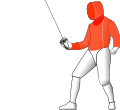Frequently Asked Questions
Do You Have Any Questions?
- Fencing is an Olympic sport and a NCAA Collegiate sport with scholarship opportunities available for fencers athlete at some of the top nation's universities.
- Fencers has a distinct advantage when it comes to college applications. 38% of female fencers and 32% of male fencers go on to fence in college. Compare that to football (7.8%) or basketball (6.3 % female, 6.9% male).
- Fencing is extremely safe. This is an sport that has little risk of serious injury while offering important benefits that will help your child grow with confidence, self-discipline, quick-thinking, and respect.
- Fencing is a life-long sport where physique and age are not limitations. Often referred to as "physical chess", fencing develop your mind as well as your body.
- Fencing can satisfy PE Credit Hours for Middle and High School students.
Fencing is a sport that all ages (5-6 to 80+) can participated and compete.
The age groups are as follow:
Youth 10 (7 to 10)
Youth 12 (10 to 12)
Youth 14 (12 to 14)
Cadet (13 to 17)
Junior (13 to 20)
Senior (13 to 39)
Veterans (40 to 80+)
No. The practicing equipment (mask, glove, jacket, chest and underarm protector, and weapon) is provided for all the classes.
The equipment for competitions can be rent by the club or purchase online at The Fencing Post
According to 2019 US Fencing chart:
40, 000 Members in 50 States
715 USA Fencing Clubs
35 USA Parafencing Programs
33 World Championship Medals
4 International Events
8 National Events
144 Regional Events
1,000s Hours of Volunteers throughout the nation
FOIL

Weapon A thrusting sword, like the epée, with a flexible rectangular blade, weighing less than one pound and with a smaller guard.
Scoring & Target The valid target area is the torso, from the shoulders to the groin, front and back. It does not include the arms, neck, head or legs. Touches are scored similar to epée by using the tip of the blade.
Equipment Like epée, the foil is connected by a body cord to the scoring machine. Additionally a metallic vest, called a lamé, which covers the target area, so that a valid touch will register on the scoring machine, and an electric fencing mask is being used.
The foil has a flexible rectangular blade, approximately 35 inches in length, weighing less than one pound. Points are scored with the tip of the blade and must land within the torso of the body.
EPEE

Weapon The descendant of the dueling sword, epée is the heaviest of the three weapons, weighing approximately 27 ounces. It has a larger bell shaped guard and a much stiffer blade.
Scoring & Target Touches are scored with the tip of the blade anywhere on the opponent’s body, from the top of the head to the tip of the toe. In epée the fencing strip (area where a fencing bout takes place) is metallic in order to prove when the blade touches the ground instead of the opponent (invalid point).
Equipment In addition to the regular protective gear, épée fencers use an electric body cord that connects the weapon to the scoring machine.
A bit about Fencing
The ancestor of modern fencing originated in Spain, where several books on fencing were written. Treatise on Arms was written by Diego de Valera between 1458 and 1471 and is one of the oldest surviving manuals on western fencing shortly before dueling came under official ban by the Monarchs of the time.
Fencing is also one of the only four sports that have been present at every single Olympic Games. It is often called the physical chess as it not only a great exercise for the body but also for the mind.
SABRE

Weapon The modern version of the slashing cavalry sword, similar in length and weight to the foil. The guard curves over the handle to protect the fist.
Scoring & Target Saber is a "thrusting" weapon as well as a "cutting" weapon (using the tip as well as the side of the blade). The target area is from the waist line up, including the arms, to the top of the head, simulating the cavalry rider on a horse.
Equipment The saber fencer's uniform includes a sleeved metallic jacket (lamé) on top of the regular one, which covers the target area to register valid touches on the scoring machine. The mask is different from foil and epée with an entire metallic covering, since the head is a valid target area, too.